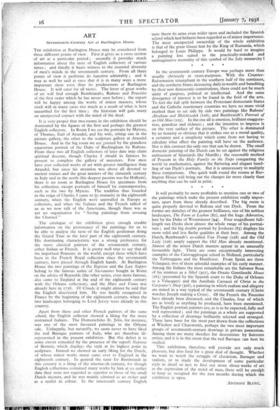In the seventeenth century Europe was perhaps more than usually
obviously at cross-purposes. With the Counter- Reformation triumphant in the southern half of the continent; and the northern States increasing daily inwealth and benefiting by their new democratic constitutions, there could not be much unity of purpose, political or intellectual. And the same divergence of interest is to be found in the field of the arts. To feel the full split between the Protestant democratic States and the Catholic reactionary countries we have no more vivid method than to set side by side two paintings like Rubens' Abraham and Melchizedek (to6), and Rembrandt's Portrait of an Old Man (125). In the one all is emotion, brilliant exaggera- tion, grandeur and richness ; and the intention to impress is on the very surface of the picture. The other is dominated by an honesty so obvious that it strikes one as a moral quality, a certainty and a simplicity which come from not having to calculate what effect the painting will have on the audience. Nor is this contrast the only one that can be drawn. The small domestic painting of the Dutch can be set against the religious enthusiasm a Spaniards like Murillo ; the reasonable method of Poussin in the Holy Family on the Steps conquering the world by mathematics, against the flattering and elegant hand- ling of van Dyck's portraits. But it is unnecessary to multiply these comparisons. One quick walk round the rooms at Bur- lington House will bring out the changes far more clearly than anything that can be said in print.
* * * *









































 Previous page
Previous page